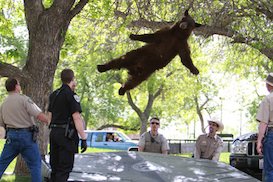As soon as he took the picture, Janis Krums knew he had something. What he didn’t know is how much of a something he really had.
If Krums’ name sounds familiar, it’s because he took one of the most famous viral pictures of all time — the first image of the U.S. Airways jet that landed in the icy Hudson River on Jan. 15, 2009, with all passengers surviving.
Krums, who was on a ferry at the time, uploaded the photo to TweetDeck and tweeted out the link. Within 34 minutes he was being interviewed live on MSNBC.
http://twitpic.com/135xa – There’s a plane in the Hudson. I’m on the ferry going to pick up the people. Crazy.
— Jānis Krūms (@jkrums) January 15, 2009
Throughout the day he was inundated with requests to use his instafamous photo, Krums told me by phone: “Basically everyone” was trying to get the rights to the photo, including the Associated Press.
“The money they were offering was kind of a joke,” Krums said of his media suitors. He ultimately decided to copyright the photo himself, and credits that decision to advice from a handful of photographers who contacted him via Twitter.
“Photographers tweeted me and said, ‘Hey, just so you know, this is the ballpark’” for what the photo is worth, Krums said.
The age of the citizen photographer is upon us. And while anybody with a phone or camera can take a picture that goes viral, that doesn’t necessarily mean they will be fairly compensated for it.

- AP pulled a photo of a bear falling from a tree on the University of Colorado campus after student Andy Duann asserted he, not the university, owned the copyright on it. (Photograph by Andy Duann)
To help level the playing field, some media-savvy professional photographers are taking matters into their own hands, reaching out to amateurs who were in the right place at the right time and letting them know that their viral pictures have value. They’re also urging them not to grant media requests to use their photos free of charge, no matter how flattered they may feel to be asked.
Some of the advice is motivated by simple fairness. But another factor is the pros’ anger at the continuing erosion of professional photo staffs by news organizations that are looking to save money and see free labor from amateurs as a way to do so.
On Jan. 4, photographer Gary He provided guidance to an Instagram user who had taken a photo of a small plane that crashed on the Major Deegan Expressway in the Bronx.
“Even at a professional level, photographers don’t really understand licensing and copyright all that well,” said He, director of operations at a New York-based photo agency, in an email message. “So you can imagine that a random dude on Instagram must really have a hard time.”
In the comments section of the Instagram photo, several major agencies requested permission from Paul Collado, user name fattypaul89, to use the photo.
Gary He’s advice for Collado: “Do not let news channels or newspapers use your photos without a licensing fee. Standard for a non-exclusive is $200 and up.”
After corresponding with He, Collado asked several media requesters “how much.”
A broader question, which is still being hammered out, is what rights are granted when a photographer gives online consent to a media outlet that asks to use a photo. The author of the photo retains its copyright, but may license it to a news agency like the Associated Press for a fee. An alternative is to register the copyright independently.
“The plane-crash photographer seemed like a nice dude who didn’t have too many selfies in his Instagram feed, so I thought he could stand to make a couple hundred dollars,” He told me.
More recently, the unofficial Viral Photo Of The Week (1/12-1/19) was taken by Amanda Traver, who captured the dense fog enveloping New York City from an airplane above.
Traver, who posted the photo on Instagram, was quickly inundated with media requests to use the image.
San Francisco-based photojournalist Steve Rhodes offered Traver some advice: “You should ask all the news media using or asking for your photo to pay you.”
“All the people offering you credit are paid and you should be too,” Rhodes told Traver, adding that “they wouldn’t work just for ‘credit.’ ”
After Rhodes weighed in, Daniel Avila — a New York-based staff photographer who posts under the name DGAPix – had some wisdom of his own for Traver: “Great shot. You don’t have to let any news org use your photo without asking for a license fee! :)”
“I think it’s important for people to know what their rights are regarding licensing and royalties, and how to not mistakenly give them up completely,” Avila said by email.
One reason for insisting on being paid comes from Gary He, who said the “exposure” offered by media outlets isn’t worth that much – in his view, users on social media probably bring an amateur photographer’s work “more eyeballs than any news channel or newspaper could’ve gotten.”
Avila said he was inspired by seeing other professional photographers offer guidance to amateurs, but added that he saw the question of compensation as part of a larger issue: “It’s also about the upsetting fact that more and more news organizations are turning to social media and amateur smartphone photography as a replacement of their photo staff.”
Krums agreed. News organizations are “taking money away from professional photographers,” he said, adding that as long as amateurs give their shots away for free, “there’s no incentive for the big players to change what they’re doing.”
Related: How citizen journalism has changed since George Holliday’s Rodney King video | Texas doctor who captured iconic image of Columbia disaster is now a working photographer | Meet Gary He, creator of the Obama-as-Truman meme | Poynter’s vast archives about Andy Duann’s “falling bear” photo







Comments